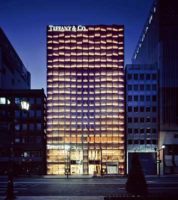Tokyo
An icon in the making, Ginza Place is the latest addition to Tokyo’s Ginza 4-Chome Crossing—the city’s equivalent of the intersection at New York’s Fifth Avenue and 57th Street. Marking one corner, this 11-story commercial building is defined by webs of metal panels tautly stretched across its wraparound facade. By day, the eye-popping surface is hard to miss. But at night its backlit front becomes a focal point of the city’s most famous junction.
Recently completed by Klein Dytham architecture (KDa), the project began after the Tokyo-based firm won a 2013 competition to design the building’s facade and massing. Though the landowner, Sapporo Real Estate, and the construction company, Taisei Corporation, had already determined the floor plate size and reinforced-concrete structure, the project needed a signature architect to give it a strong identity, explains KDa coprincipal Mark Dytham. Known for clever and highly creative solutions, KDa was a logical choice for this extremely high-profile job.
“It was a one-in-a-million chance,” says Dytham’s partner, Astrid Klein. Making the most of the opportunity, the architects developed a freestanding L-shaped volume for the tight site that accommodates an existing building in the back and maximizes tenant space with a faceted front. To smooth out the resulting kinks and edges on the exterior, KDa created a bold facade with an illusory curved surface that the architects separated into three horizontal bands—small, medium, and large—that echo the tripartite composition of a 1932 department store kitty-corner from the site. These bands are interspersed with rows of windows and balconies at a third-floor café and seventh-floor restaurant, both overlooking Ginza’s main street. A radical move in a shopping district where balconied buildings are nonexistent, these openings resulted in an unprecedented relationship between the interior and the elegant boulevard below. Plus, they place restaurant patrons directly in line with a historic clock tower at the top of the adjacent building. Additional glass walls on the ground and second floors reveal the showrooms of anchor tenants Sony and Nissan.
The entire facade consists of 5,315 aluminum panels that expand in size as they rise up—like bubbles in a beer glass, according to Dytham. Within each of its three segments, the diamond-shaped pieces align diagonally. Barely separated by 0.3-inch joints, they read as a series of overlapping curved lines with a checkerboard of voids in between. Some of the gaps are plugged with small windows; others are open to the concrete wall behind. The motif culminates at the top where swooping parabolas guide the gaze upward.
Ranging from 1 to 16 feet high, the panels consistently measure 3 feet across and 2 inches deep. Each one is backed with L-shaped hardware that attaches to rails affixed to the building. Developed by KDa and Taisei, this patented system enables the panels to slide without racking during an earthquake. Folded flaps at the panel edges conceal these underpinnings, while center creases create depth.
The panels’ three-dimensionality not only articulates the facade, it also helps mitigate the building’s north-facing orientation. Coated with pearlescent white paint, the metal surfaces pick up movement and light outside. “They reflect Ginza back on itself,” says Dytham. At night, the panels are lit from behind with a ColorBlast 6 LED system created by Philips Color Kinetics. Attached to the rails via a simple 90-degree bracket between the metal screen and the concrete base building, these lighting fixtures are positioned between some of the panels so that they illuminate the perforations in the facade, following the overall flow of its geometry. Designed to subtly adjust the building’s character seasonally, the lighting ranges in color from a cool blue in the summer to a warm candlelight in winter and a neutral white for fall or spring.
Like a beacon in the dark, Ginza Place draws attention to one of Tokyo’s symbolic centers with an intricate facade that bows politely to Japan’s tradition of craft and also showcases its cutting edge technology—bringing the best of the city to light.






Post a comment to this article
Report Abusive Comment